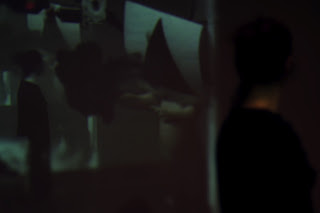Model Space
Space จำแลง
โดยส่วนใหญ่แล้วคนเรามักมีความเชื่อมั่นในประสาทสัมผัสของตนเอง เราได้กลิ่น เราได้ยิน เราได้รส เราได้เห็น เราได้สัมผัส แล้วเราก็เกิดความเชื่อที่ว่า สิ่งที่ได้รับรู้ (percept) นั้น คือ ความเป็นจริง (reality)ซึ่งจะส่งผลต่อการกระทำ การตัดสินใจ และความคิดในเวลาต่อมา หรือที่เรียกว่า การตอบสนอง (reaction)แต่อันที่จริง การตอบสนองทั้งหมดนั้นอาจไม่ได้มีเหตุมาจากการรับรู้ทางกายภาพแต่เพียงอย่างเดียวเท่านั้นแต่ยังผสมรวมไปด้วยปัจจัยอื่นอีกมากมาย ไม่ว่าจะเป็น ความทรงจำ ประสบการณ์ สถานการณ์ ตลอดจน จินตนาการและความคาดหวังในสิ่งที่ยังไม่ได้เกิด จนดูเหมือนว่าการรับรู้นั้นจะเป็นเพียงจุดเริ่มต้นเล็กๆที่ก่อให้เกิดผลที่ตามมาอย่างมหาศาล
แล้วเราจะเชื่อในสัมผัสของเราได้แค่ไหนเมื่อเพียงลำพังการหลับฝัน เราก็สามารถรับรู้ได้ถึงภาพต่างๆนานาที่ส่งกระทบต่อความคิดและจิตใจได้เช่นกัน หรือแม้แต่การจินตนาการเพียงอย่างเดียว ก็สามารถส่งให้เกิดผลทางความคิดและก่อให้เกิดการกระทำต่อมาได้ยิ่งกว่า แรงขับจากโลกแห่งความคิดจะมีอิทธิพลต่อการ กระทำของเราได้มากน้อยเพียงใด และแรงขับจากโลกเสมือนจริงอันถูกสร้างขึ้นด้วยวิธีการต่างๆของมนุษย์ที่อาจไม่ครบถ้วนทางด้านผัสสะ จะโน้มน้าว ความเชื่อ ความคิดของผู้ชมได้มากแค่ไหน
ผล งานศิลปะชุดนี้ คือ สถานการณ์จำลองที่ถูกสร้างขึ้นเพื่อทดลองเกี่ยวกับข้อสงสัยข้างต้น โดยมีรูปแบบคล้ายนิทรรศการศิลปะอย่างขนบที่ถูกจัดแสดงในห้องแสดงงานทั่วไป เพียงแต่ผลงานทั้งหมดนั้นไม่ได้มีอยู่จริงเลยแม้แต่ชิ้นเดียวทว่าปรากฏอยู่ บนผนังห้องที่ถูกฉายให้เป็นภาพบรรยากาศของห้องนิทรรศการด้วยโปรเจ็คเตอร์ เป็นดังกระจกบานใหญ่ที่สะท้อนให้เป็นอีกหนึ่งมิติที่ซ้อนอยู่ภายในห้อง นิทรรศการ ซึ่งนั่นก็คือโลกเสมือนที่ถูกสร้างขึ้นมานั่นเอง แล้วในความไม่ครบถ้วนสมบูรณ์นี้จะสร้างปฏิกริยาโต้ตอบต่อผู้ชมงานได้ในลักษณะไหนบ้าง ผู้ชมจะสามารถเชื่อ ยอมรับ และ คล้อยตาม ไปกับการรับรู้แบบเสมือนจริงนี้ได้มากน้อยเพียงใด …
Most people believe in their sensory perception. We smell, hear, taste, see and touch, and then we believe that what we perceive is reality, and that reality will later affect our behaviors, decisions and thoughts; this is the process called reaction. However, reactions are caused not only by the senses, but also by many other factors, such as memories, experiences, situations, as well as imaginations and expectations for things to happen. It is also possible that sleeping, thinking and dreaming also conjure up some images which can have impact upon our thoughts and minds.
The questions are how much these mental factors can influence our behavior and how much the impulsion from man-made simulated world, which may not be complete in terms of sensorial dimensions, can convince the audience’s thoughts and beliefs.
This work is a simulation created to experiment on the questions above. Its format is similar to a typical art exhibition displayed in a rectangular room, but not even one piece of the works is a real object. They appear as projected images on the wall to show the atmosphere of an exhibition room, like a large mirror reflecting another overlapping dimension. It is a simulated world, physically incomplete one, which can be “seen” but untouchable. Movement of images can be controlled, but they are still “the unreal”. How can the audience react with this incompleteness, and how much can the audience believe, accept and follow this virtual perception? …
ALL from
witaya junma on
Vimeo.




